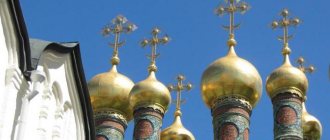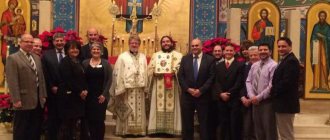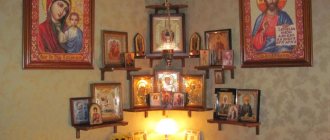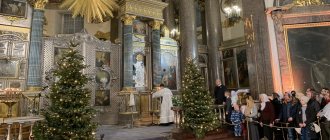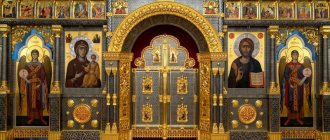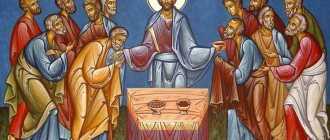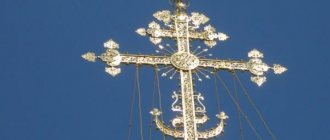What is an iconostasis
The word “iconostasis” came from Greece, where it was formed from two parts: “εἰκών” - image and “στάσις” - standing place. The exact meaning of this word means a partition with images that separates the altar from the middle part of the temple.
Iconostasis - a partition with rows of icons separating the altar from the main part of the temple
Most often it is a large wall reaching to the ceiling, on which icons are located in 3-5 tiers. Occasionally there are low partitions and not solid ones - they allow you to see everything that happens in the altar.
The ranks are arranged from top to bottom and sequentially tell the parishioner the story of God’s creation of man, and the entire history of their relationship. The images and their arrangement differ from temple to temple, but traditionally they are divided into 5 tiers:
- The topmost, fifth tier is the Forefathers.
- The fourth rank is Prophetic.
- The third tier is Festive.
- The second tier is the Deesis.
- The lower rank or first tier is called the Local Row.
Important!
Separating the middle church from the altar, the iconostasis allows us to preserve the sacrament of prayer of the clergy and their preparation for the service. The design of such a partition also has a spiritual meaning - the special arrangement of paintings on it tells the parishioner the story of the creation of man by the Lord. At the top there is always a cross, as a symbol of the culmination of God’s love for man - it was on the cross that Jesus Christ died for all humanity, because God loved this world so much that He sacrificed His Son for it. Occasionally, instead of a crucifix, there may be an icon of the “Crucifixion” on the top of the partition.
Origin story
Early Christian history contains no mention of iconostases - initially they simply did not exist, because Christians were forbidden to gather in buildings and were forced to hold services in caves.
Subsequently, when Christianity became an officially permitted religion and the number of parishioners increased, services were moved into buildings, and the place of priest training began to be separated by columns, on which icons were occasionally placed. Only in the 4th century AD. There were references to specially constructed altar barriers in churches.
The iconostasis symbolizes the Kingdom of Heaven
Initially, the barriers were low, making it impossible to completely hide what was happening in the altar. But as the church was decorated with images of saints, they were expanded and made taller. The first appearance of a 4-tier iconostasis dates back to the beginning of the 15th century.
Iconostases developed their development in Ancient Rus' - in Greece, services were held in stone churches, which were decorated abundantly with frescoes, and in the territory of the modern CIS, churches were predominantly wooden, so there was a need for stands for holy images. From the beginning of the 15th century, 4-tier iconostases began to be installed everywhere, but today the 5-tier iconostasis is considered the classic option.
Tiled icons of Dmitrov and Staritsa are the only ones found on the territory of Ancient Rus'
In 1558-1561, Staritsky Prince Vladimir Andreevich built the tented cathedral of Boris and Gleb, which has several ceramic icons. It is also known that after the dismantling of the temple in the 19th century, two of them, the Crucifixion and the Savior Not Made by Hands, were moved to the facades of the now existing Boris and Gleb Cathedral.
Ceramic icon of the Crucifixion of the Boris and Gleb Cathedral in Staritsa, Tver region.
At the beginning of the twentieth century, archaeological excavations took place among the foundations of the Boris and Gleb Cathedral, during which fragments of glazed relief ceramics were found. The nature of the ornaments of the found tile fragments is Western European, close to the ornaments of the Italian Renaissance. The craftsmanship and, above all, the type of product itself - relief glazed ceramics - seem to be a completely unique phenomenon for Ancient Rus'. All found fragments were monochrome painted with green and yellow glazes.
Similar tiled ceramic icons, reaching a very impressive - three-meter - height, are found on the territory of the Moscow state only on one other monument - at the Assumption Cathedral in Dmitrov, built in the first quarter of the 16th century. This is a round icon of St. George the Victorious under the arches of the southern porch of the cathedral and two Crucifixions with upcoming ones in the central corners of its northern and southern facades. The origin of the icons of the Assumption Cathedral in Dmitrov remains unclear to this day. The three Dmitrov icons are identical in style and technique to the three Staritsa ones.
Ceramic tondo “The Miracle of St. George on the Serpent”
For the first time, the “image of the Great Martyr George made of enamel slabs ... of ancient workmanship” that was on the porch was mentioned in the description of the cities of the Moscow province in 1787. The ceramic crucifixes on the southern and northern facades of the cathedral were erroneously described in the 1813 Inventory as “pieces of lebastra,” which was repeated in subsequent inventories. Traces of lime painting have been preserved in the recesses of the tile reliefs. The painting was probably done to give the tiles a more “classical” look, according to the tastes of the early 19th century. Many researchers date the icons of the Assumption Cathedral to the mid-16th century and compare them with the tiles of the Boris and Gleb Cathedral in the city of Staritsa, noting that the icons are local work, characteristic of Central Russian sculpture before the Novgorod traditions.
Ceramic icon on the facade of the Assumption Cathedral in Dmitrov
Apart from these two old county towns - Dmitrov and Staritsa, tiled icons have not been found anywhere else on the territory of Ancient Rus'. Neither the 15th, nor the 16th, nor, with insignificant exceptions, even the 17th century knows tiled icons.
How the iconostasis works in an Orthodox church
The iconostasis has a strict canonicity - you cannot violate the order of the icons on it, but at the same time, the style of construction does not have strict boundaries, so there are quite a few types of altar barriers.
Bottom row
Here the central place is occupied by the Royal Doors - the doors that lead to the altar (located opposite the Throne) and symbolize the doors to Paradise. On the doors facing the hall there are icons of the Annunciation and the four evangelists. Above the gate is the “Last Supper”, and to the left and right along the edges of the rank are the deacon’s doors through which all the clergy enter the hall.
In the first tier of the iconostasis in the middle there are the Royal Doors
The main image of the bottom row is the image of Christ and the Virgin Mary; they are located to the right and left of the Royal Doors, respectively. After them, local icons are installed - images of saints in whose honor the temple is named or who are especially revered here.
Second row
This rank contains smaller icons than the first, but there are more of them overall. The main theme of the series is the second coming of Jesus Christ to earth, which is why it is called Deesis. The main image of the rite is the image of the Savior on the throne, and in general the collection is subordinated to one theme - a prayer to Christ for mercy.
The Deesis second row symbolizes the Church’s prayer to Christ
On the right and left sides of the main picture are images of John the Baptist and the Virgin Mary “Intercessor”.
Third row
The third tier or Festive collects all the images that depict the twelve feasts - the great events that occurred in the life of Christ and the Virgin Mary. Sometimes it is called Historical, because it tells a brief history of the Gospel, showing people the most significant events: Christmas, Epiphany, Annunciation, etc.
The third row introduces parishioners to the events of the Gospel story
Fourth row
The fourth tier is where the prophets are located, which is why it is called prophetic. Its main goal is to acquaint and introduce people to the history of the Old Testament Church. Therefore, all those people of God who prophesied about the coming and death of Jesus are represented here. In addition to them, the tier contains a painting of the Virgin Mary “The Sign”.
The fourth row depicts the prophets who announced future events
Fifth row
The forefathers' rank in the center contains the image of the Holy Trinity, showing that the Lord is at the head of everything and He was originally there before the creation of the Universe. On both sides of the Holy Trinity there are images of the righteous of the Old Testament: the forefathers Abraham, Isaac and Jacob. There is no clear rule about who exactly should be represented on the icons - this is determined by the one who orders the entire partition.
The top of the iconostasis is crowned with an image of the crucifixion
Symbolism
The construction and structure of the iconostasis are regulated by church traditions, but their architecture, style and appearance may vary. However, certain symbolism can still be traced:
- The crucifix is a symbol of the death of Christ, thanks to which a person has eternal life. It is always located at the top of the partition, crowning the entire history of the relationship between man and God.
- Each rank is a certain stage in the history of the Church, starting with the creation of the world and ending with the Kingdom of Heaven.
- The central icon in the tier determines the theme; it is from it that one can understand what rank it is.
- At the center of each rank are the images of Jesus Christ and the Holy Trinity - it is the Lord who is the center of the Universe and human life. Therefore, in any iconostasis there can be seen a clear arrangement of these images, one under the other from top to bottom.
- The theme of the images of the Mother of God on each tier corresponds to the general theme, so on the Deesis it is the “Intercessor”, begging for mercy for sinners, and on the Prophetic it is the “Sign”, confirming all the prophecies about the coming of the Messiah.
At the same time, the style of the iconostasis as a whole, as well as the style of the icons and their content, can differ significantly from temple to temple. Thus, the image of the Last Supper can be replaced by the “Resurrection of Christ”, and the images of the holidays - by paintings from the cycle “The Passion of Christ”.
Ceramic iconostasis of the New Jerusalem Monastery - the most famous Russian monuments
The most famous and largest Russian monument is the ensemble of the New Jerusalem Monastery with an abundance of ceramic iconostases and architectural details. As you know, Patriarch Nikon wanted to reproduce in the monastery’s Resurrection Cathedral the architectural decor of the Jerusalem Church of the Holy Sepulcher, made of mosaics and colored marble. In Russia, natural marble was too expensive, so they decided to use traditional Russian tiles - tiles made of baked clay. Beginning in the 1660s, nine chapels with ceramic iconostases were built and consecrated in the Resurrection Cathedral. Famous Belarusian masters worked on the ceramic decoration: Pyotr Zaborsky, Stepan Polubes, Ignatius Maksimov.
Ceramic iconostasis of the Resurrection Cathedral of the New Jerusalem Monastery
In addition, the cathedral was decorated with tiled icon frames, decorative belts, portals and inscriptions. At the end of the 17th century, the drum of the large dome of the cathedral, the parapets of the choir and the upper tiers of the temple were decorated with tiles. The ceramic frieze, which has received the names “burdocks”, “peacock tail”, “peacock eye” in literature, has great symbolic significance. This image was a stylized pomegranate flower, similar to the eyes on the feathers in the tail of a peacock, and was quite widespread in the decor of churches in Moscow in the 17th century. The tiles made in the New Jerusalem Monastery are unique ceramics that have no similar in Russian architecture [2].
Ceramic decoration of the facade of the Resurrection Cathedral of the New Jerusalem Monastery
After the ceramic iconostases of the 17th century, the history of Russian tiled art did not know such examples for a long time. It is no coincidence that in the mid-19th century, Archimandrite Leonid (Kavelin), a researcher of the tiles of the New Jerusalem, highly appreciating the ceramic iconostasis of the cathedral, regretted that in his time “there were no hunters to resume the application of treasury to the internal decoration of churches” [3].
Ceramic iconostasis in the Church of the Annunciation of the Blessed Virgin Mary. Novotomnikovo, Tambov region.
After this, for a long time no one in Russia made such iconostases. N.V. resumed their production. Sultanov, who studied the history of tiles and published archival materials on this topic. Nikolai Vladimirovich designed the iconostasis for the Church of the Annunciation in the village of Novotomnikovo, Tambov province, made in 1889 at the brick factory of M.V. Kharlamov in St. Petersburg.
